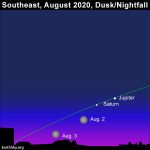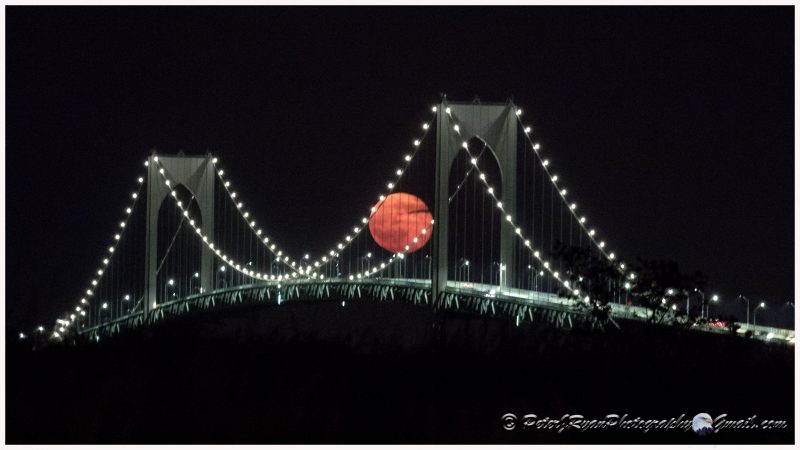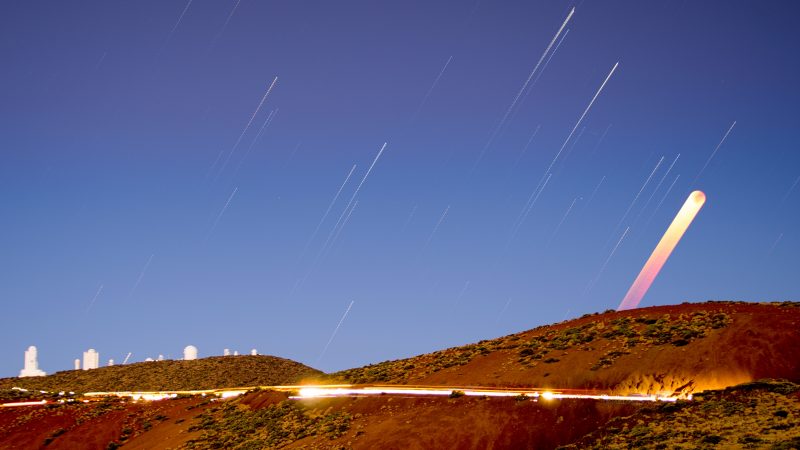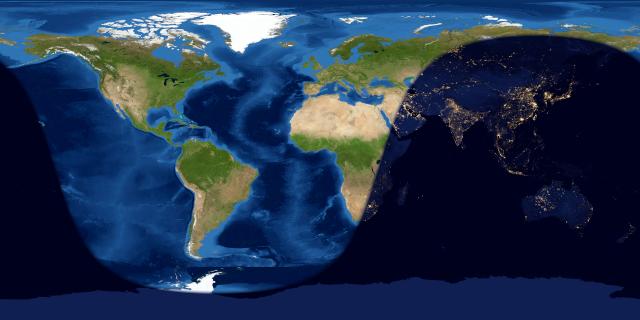
We hereby give the August 2 and 3, 2020, full moon a new name: Fist-Shaking Moon. That’s because this full moon is now filling the sky with its light, just as the Perseid meteor shower is rising to its peak on the mornings of August 11, 12 and 13. Yes, the moon will wane in the coming days. But a full moon now means a last quarter moon on August 11. And a last quarter moon is a pretty bright moon, rising at midnight, just as the night’s meteor-watching kicks into full gear. As for us, we’ll be standing outside shaking our fists at this full moon. Will moonlight ruin this year’s Perseids? It’ll surely exert an influence. Here’s how you can optimize your meteor-watching chances this month.
Everyone around the world (except far-northern Arctic latitudes) will see a full-looking moon lighting up the nighttime from about dusk until about dawn on these nights. This bright full moon will be following the planets Jupiter and Saturn westward across the sky throughout the night.
In North America, we also call the August full moon the Sturgeon Moon, Green Corn Moon or Grain Moon. For the Northern Hemisphere, this August full moon ushers in the second of three full moons of the summer season.
In the Southern Hemisphere, where it’s the opposite season, this is second of three winter full moons.
By season, we are referring to the time period between the June solstice and the September equinox.

A lovely shot of the June 10, 2017, moon from Peter Ryan in East Greenwich, Rhode Island.
It’s very hard to tell when a moon is precisely full just by looking at it. This month’s moon turns precisely full on August 3 at 15:59 UTC (translate UTC to your time). At U.S. time zones, that translates to 11:59 a.m. EDT, 10:59 a.m. CDT, 9:59 a.m. MDT, 8:59 a.m. PST, 7:59 a.m. AKDT, and 5:59 a.m. HST. But those times indicate only the crest of the moon’s full phase. They indicate when the moon is most opposite the sun for this month (180 degrees from the sun in ecliptic longitude).
Submit your full moon photo to EarthSky Community Photos
To the eye, on the other hand, the moon appears over 99% illuminated for about a day before and after full moon. People around the world will regard the moon as full on both August 2 and August 3.
Visit Unitarium.com or Heavens-Above.com to know how much of the moon’s face is illuminated in sunlight for right now or any chosen time.
At about the time of the full moon, the moon rises in the east around sunset, climbs highest up for the night around midnight and sets in the west around sunrise. So these next few nights, look for the moon in your eastern sky at dusk and your western sky at dawn.
Want to know the exact time for the full moon at your locality, plus the moonrise and moonset times? Sunrise Sunset Calendars gives the times. Remember to check the Moon phases and Moonrise and moonset boxes.
This August 2020 full moon does not pass through the antisolar point – the point that’s exactly opposite the sun – or else this full moon would undergo a total lunar eclipse. The last time the full moon passed through the antisolar point and through the center of the Earth’s dark umbral shadow was over two years ago, when it staged the longest total lunar eclipse of the 21st century (2001 to 2100) on July 27, 2018.

The July 27, 2018, eclipsed moon rises over the observatories of Instituto Astrofisica de Canarias, in Tenerife. Roberto Porto acquired 200 images to make this star trail composite. See more photos of the July 27, 2018, lunar eclipse.
Last month, in July 2020, the full moon missed the antisolar point and swung south of Earth’s dark umbral shadow. Yet the moon did clip the southern portion of the Earth’s faint penumbral shadow to present a partial penumbral eclipse on July 5, 2020.
The full moon won’t sweep through the Earth’s umbra again until May 26, 2021. But the moon will swing well north of the antisolar point, to display the second-shortest total lunar eclipse of the 21st century (2001 to 2100).
The full moon won’t meet up with the antisolar point until it barely grazes the center of the Earth’s dark shadow during the total lunar eclipse of May 16, 2022.
The worldwide map below shows the day and night sides of Earth at the instant of the August 2020 full moon (August 3, 2020, at 15:59 UTC). The shadow line at left represents sunrise August 3 whereas the shadow line at the right depicts sunset August 3.
You have to be on the nighttime side of Earth to see the moon at the instant it turns full.

The day and night sides of Earth at the instant of full moon (August 3, 2020, at 15:59 UTC). The shadow line at left (running across the Pacific Ocean) depicts sunrise August 3, and the shadow line at right (running across Africa and the Middle east) represents sunset August 3. Worldwide map via EarthView.
Bottom line: On both August 2 and 3, 2020, the brilliant full moon drenches the nighttime with moonlight from dusk until dawn. A full moon now means a last quarter moon – shining in the sky between midnight and dawn – on August 11, one of the peak mornings of this year’s Perseid meteor shower.
from EarthSky https://ift.tt/2YXLxHv

We hereby give the August 2 and 3, 2020, full moon a new name: Fist-Shaking Moon. That’s because this full moon is now filling the sky with its light, just as the Perseid meteor shower is rising to its peak on the mornings of August 11, 12 and 13. Yes, the moon will wane in the coming days. But a full moon now means a last quarter moon on August 11. And a last quarter moon is a pretty bright moon, rising at midnight, just as the night’s meteor-watching kicks into full gear. As for us, we’ll be standing outside shaking our fists at this full moon. Will moonlight ruin this year’s Perseids? It’ll surely exert an influence. Here’s how you can optimize your meteor-watching chances this month.
Everyone around the world (except far-northern Arctic latitudes) will see a full-looking moon lighting up the nighttime from about dusk until about dawn on these nights. This bright full moon will be following the planets Jupiter and Saturn westward across the sky throughout the night.
In North America, we also call the August full moon the Sturgeon Moon, Green Corn Moon or Grain Moon. For the Northern Hemisphere, this August full moon ushers in the second of three full moons of the summer season.
In the Southern Hemisphere, where it’s the opposite season, this is second of three winter full moons.
By season, we are referring to the time period between the June solstice and the September equinox.

A lovely shot of the June 10, 2017, moon from Peter Ryan in East Greenwich, Rhode Island.
It’s very hard to tell when a moon is precisely full just by looking at it. This month’s moon turns precisely full on August 3 at 15:59 UTC (translate UTC to your time). At U.S. time zones, that translates to 11:59 a.m. EDT, 10:59 a.m. CDT, 9:59 a.m. MDT, 8:59 a.m. PST, 7:59 a.m. AKDT, and 5:59 a.m. HST. But those times indicate only the crest of the moon’s full phase. They indicate when the moon is most opposite the sun for this month (180 degrees from the sun in ecliptic longitude).
Submit your full moon photo to EarthSky Community Photos
To the eye, on the other hand, the moon appears over 99% illuminated for about a day before and after full moon. People around the world will regard the moon as full on both August 2 and August 3.
Visit Unitarium.com or Heavens-Above.com to know how much of the moon’s face is illuminated in sunlight for right now or any chosen time.
At about the time of the full moon, the moon rises in the east around sunset, climbs highest up for the night around midnight and sets in the west around sunrise. So these next few nights, look for the moon in your eastern sky at dusk and your western sky at dawn.
Want to know the exact time for the full moon at your locality, plus the moonrise and moonset times? Sunrise Sunset Calendars gives the times. Remember to check the Moon phases and Moonrise and moonset boxes.
This August 2020 full moon does not pass through the antisolar point – the point that’s exactly opposite the sun – or else this full moon would undergo a total lunar eclipse. The last time the full moon passed through the antisolar point and through the center of the Earth’s dark umbral shadow was over two years ago, when it staged the longest total lunar eclipse of the 21st century (2001 to 2100) on July 27, 2018.

The July 27, 2018, eclipsed moon rises over the observatories of Instituto Astrofisica de Canarias, in Tenerife. Roberto Porto acquired 200 images to make this star trail composite. See more photos of the July 27, 2018, lunar eclipse.
Last month, in July 2020, the full moon missed the antisolar point and swung south of Earth’s dark umbral shadow. Yet the moon did clip the southern portion of the Earth’s faint penumbral shadow to present a partial penumbral eclipse on July 5, 2020.
The full moon won’t sweep through the Earth’s umbra again until May 26, 2021. But the moon will swing well north of the antisolar point, to display the second-shortest total lunar eclipse of the 21st century (2001 to 2100).
The full moon won’t meet up with the antisolar point until it barely grazes the center of the Earth’s dark shadow during the total lunar eclipse of May 16, 2022.
The worldwide map below shows the day and night sides of Earth at the instant of the August 2020 full moon (August 3, 2020, at 15:59 UTC). The shadow line at left represents sunrise August 3 whereas the shadow line at the right depicts sunset August 3.
You have to be on the nighttime side of Earth to see the moon at the instant it turns full.

The day and night sides of Earth at the instant of full moon (August 3, 2020, at 15:59 UTC). The shadow line at left (running across the Pacific Ocean) depicts sunrise August 3, and the shadow line at right (running across Africa and the Middle east) represents sunset August 3. Worldwide map via EarthView.
Bottom line: On both August 2 and 3, 2020, the brilliant full moon drenches the nighttime with moonlight from dusk until dawn. A full moon now means a last quarter moon – shining in the sky between midnight and dawn – on August 11, one of the peak mornings of this year’s Perseid meteor shower.
from EarthSky https://ift.tt/2YXLxHv

Aucun commentaire:
Enregistrer un commentaire